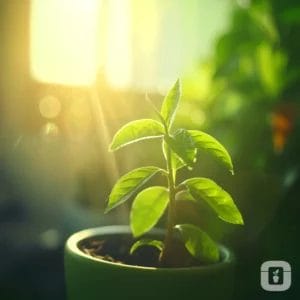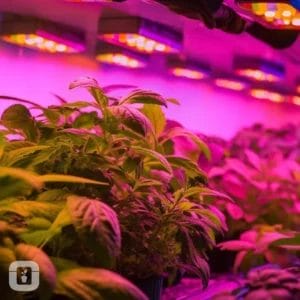
Table of Contents
Light Spectrum Introduction
Light, we often take it for granted, but it's the primary energy source for all life on Earth. For all of us, but especially for plants, light spans a broad spectrum of wavelengths, each playing its distinct role in plant growth and development. This spectrum ranges from ultraviolet (UV) light to visible wavelengths (including the typical rainbow hues of violet, blue, green, yellow, and red) and extends into the infrared. The quality of light, determined by the combination and intensity of these wavelengths, is fundamental in photosynthesis, the process allowing plants to convert light energy into chemical energy. While blue and red wavelengths are often highlighted for their critical roles in photosynthesis, other parts of the spectrum, such as green, violet, and far-red light, contribute to various plant physiological processes. This spectrum not only influences the rate of photosynthesis but also affects plant morphology, flowering, and stress responses. Understanding the intricacies of the light spectrum and its impact on our plants is essential for optimizing growth conditions, whether in natural ecosystems or controlled environments like greenhouses and an unlikely gardener's living jungle.
The Pivotal Role of Light in Plant Growth: Beyond Photosynthesis

Light is not just a photosynthesis engine; it is critically important to almost every aspect of plant growth and development. Photosynthesis, the fundamental process through which plants convert light energy into chemical energy, is highly dependent on the quality and quantity of light received. Beyond this, light influences a multitude of physiological responses: it regulates phototropism, the directional growth of a plant in response to light, ensuring the plant optimally positions itself for maximum light absorption. In the domain of transpiration, light intensity impacts the opening and closing of stomata, controlling water loss and gas exchange in plants. It's also instrumental in triggering photoperiodic responses, which include flowering and seed germination, governed by the length of day and night. Furthermore, light spectrum variations can alter plant morphology – for instance, stem elongation, leaf size, and root development. Even plant defence mechanisms against pathogens and pests are influenced by light conditions. Collectively, these aspects underscore the fundamental role light plays, not just as an energy source, but as a critical environmental signal that shapes every facet of plant life.
Specific Light Wavelengths and Their Roles
Ultraviolet Light (<400nm)
- Role in Plant Growth: Ultraviolet (UV) light, which falls below 400 nanometers (nm) in wavelength, plays a crucial role in plant morphology and chemistry.
- Benefits:
- Compact Growth: UV light tends to keep plants bushier and more compact, which is beneficial for certain types of cultivation.
- Resistance to Pests: Exposure to UV light can make plants more resistant to pathogens and insects.
- Enhanced Quality: Plants exposed to UV light often produce more terpenes and pigments, contributing to their aroma, flavor, and color.
- Application: While UV light has benefits, it's important to balance its intensity and exposure duration, as excessive UV can be harmful to plants.
Violet Light (400-450nm)

- Deep Canopy Penetration: Violet light, in the 400-450 nm range, is known for its ability to penetrate dense plant canopies.
- Advantages:
- Lower Leaf Nourishment: This deeper penetration ensures that lower leaves receive sufficient light, which is vital for the growth of high-quality flowers and fruits lower on the plant.
- Balanced Growth: It promotes balanced growth throughout the plant, not just at the top.
Blue Light (450-480nm)

- Photosynthetic Efficiency: Blue light, with wavelengths between 450 and 480 nm, is highly effective in triggering chlorophyll B photosynthesis.
- Plant Development:
- Compact Leaves: This light range helps keep leaves compact, enhancing light penetration through the canopy.
- Overall Growth Impact: Adequate blue light is essential for healthy plant development and growth.
Green Light (500-600nm)

- Role in Plant Perception: Green light, with wavelengths ranging from 500 to 600 nm, is often perceived as less significant for photosynthesis but plays a unique role in plant growth and development.
- Key Aspects:
- Deep Canopy Reach: Although plants reflect a lot of green light, giving them their characteristic color, a significant portion penetrates deeper into the plant canopy than red or blue light. This can be beneficial for plants with thick foliage.
- Regulation of Plant Processes: Green light influences specific physiological processes in plants, such as regulating leaf expansion and stem elongation.
- Photosynthetic Contribution: While less efficient than red or blue light in driving photosynthesis, green light still contributes, especially under high light conditions where it can penetrate deeper than other wavelengths.
- Enhanced Plant Coloration: Green light can improve the coloration and quality of certain plants and fruits, making them more appealing.
- Stress Response: Some studies suggest that green light can alter how plants respond to other wavelengths, potentially influencing stress responses.
- Balancing the Spectrum: Incorporating green light into a full-spectrum lighting setup can lead to more balanced and natural growth, replicating the diverse light conditions found in nature.
Red Light (600-700nm)

- Photosynthetic Driver: Red light, ranging from 600 to 700 nm, is a primary driver of photosynthesis in plants.
- Growth Effects:
- Stem Elongation: While essential, red light can cause plants to elongate their stems, especially if not balanced with blue light.
- Photosynthesis Optimization: A combination of red and blue light is often optimal for healthy plant growth and development.
Infrared / Far Red Light (700-750nm)
- Impact on Photosynthesis: Infrared or far-red light, ranging from 700 to 750 nm, influences photosynthetic efficiency via the Emerson Effect.
- Key Points:
- Emerson Effect: This phenomenon describes the increased efficiency of photosynthesis when plants absorb light at both the red (600-700 nm) and far-red wavelengths.
- Growth Regulation: Although beneficial in moderation, an excess of far-red light can lead to elongated stems.
- Balanced Spectrum: Integrating far-red light with a balanced ratio of red and blue light can enhance overall plant yield and growth.
The Impact of Light on Plant Processes

For many unlikely gardeners, light is viewed simply as this thing plants need to stay green and grow, but the impact of light on plant life is far more complex, and extends well beyond the realm of photosynthesis.
Light is obviously the driving force behind photosynthesis, the critical process where plants transform light energy into chemical energy, essential for plant growth and survival. However, light's influence permeates deeper, affecting phototropism – the directional growth that enables plants to optimally position themselves towards light sources, maximizing their energy intake.
In the sphere of transpiration, light governs the behaviour of stomata, the microscopic gatekeepers of water loss and gas exchange, thus playing a pivotal role in a plant's water management and respiratory activities. Moreover, light serves as a key environmental signal for photoperiodic responses, such as flowering and seed germination, timing these vital processes to sync with favourable seasonal conditions.
Additionally, light spectrum variations (as detailed above) bring about significant morphological changes, influencing everything from stem elongation and leaf size to root development. Light even arms plants in their defence against pathogens and pests, highlighting its role as a critical factor in the overall health and resilience of plants.
This comprehensive impact underscores the inextricable link between light and the myriad processes that define and drive plant life.
Photosynthesis and Energy Conversion
As noted, photosynthesis is the process by which plants convert light energy into chemical energy, utilizing light to power the transformation of carbon dioxide and water into glucose and oxygen. The efficiency of this process largely depends on the quality (spectrum) and intensity (PPDF - Photosynthetic Photon Flux Density) of light, with specific wavelengths driving the photosynthetic reaction. Light not only powers this fundamental process but also influences the rate at which it occurs, with different light intensities and qualities yielding varying rates of photosynthesis.
Phototropism and Plant Positioning
Phototropism, one of several tropisms that affect plant development, refers to a plant's ability to grow towards or away from light. This directional growth allows plants to optimize their exposure to light, essential for efficient photosynthesis. Photoreceptors in plants detect light and trigger growth hormones that cause the plant to bend towards the light source. This adaptation is crucial for plants in dense environments, where competition for light is high.
Transpiration and Stomatal Behaviour
Light intensity directly influences transpiration – the process of water movement through a plant and its evaporation from aerial parts like leaves. This occurs through stomata, tiny openings on the leaf surface. Light prompts the opening of these stomata, facilitating gas exchange necessary for photosynthesis. However, this also leads to water loss; hence, plants must balance the need for light absorption with water conservation.
Photoperiodic Responses like Flowering and Germination
The length of day and night, known as the photoperiod, is a critical environmental cue for many plants, influencing processes like flowering and seed germination. Some plants require long days to flower, while others need shorter periods. This response to light duration allows plants to synchronize their reproductive processes with the most favourable environmental conditions.
Morphological Changes and Defence Mechanisms
Light spectrum variations significantly impact plant morphology – the form and structure of plants. For example, different light qualities can influence stem elongation, leaf size, and root development. Furthermore, light can affect plant defence mechanisms. Certain light wavelengths can enhance a plant's resistance to pathogens and pests, possibly by triggering specific protective responses in the plant’s chemistry.
Considerations for Light Spectrum Management
Understanding and managing the light spectrum goes beyond simply providing light to plants. It includes a nuanced approach that considers a range of factors critical to optimizing plant growth and health. This includes balancing artificial and natural light sources, tailoring light spectra to different growth stages, focusing on energy efficiency and sustainability, addressing light pollution, keeping pace with technological advancements in light technology, and catering to the specific light needs of different plant species. These considerations are essential for unlikely gardeners seeking to create the most effective and efficient growing environments, ensuring that every aspect of light exposure is finely tuned to the needs of the plants.
Balancing Artificial Light with Natural Light

The balance between artificial and natural light can play a pivotal role. While artificial lighting systems offer control and consistency, they cannot entirely replicate the dynamic spectrum of natural sunlight. This is something to consider when using LED lighting to supplement natural available light.
- Importance of Natural Light: While artificial lighting provides control over light spectra, it's crucial to consider the benefits of natural sunlight in plant growth. Sunlight offers a full spectrum of light, which is challenging to replicate artificially.
- Integrating Light Sources: In controlled environments, combining artificial light with natural light can create a more balanced spectrum, leading to healthier plant growth. This is often where utilizing 'blurple' coloured lights can be of best value.
Spectral Quality and Plant Stages
As already discussed, different stages of a plant's life cycle demand varying light spectra. Spectral quality should be tailored to suit the specific stages of plant growth, such as seedling, vegetative, and flowering phases. The importance of adjustable lighting systems in providing the right spectrum at each stage, enhances overall plant health and productivity.
- Growth Stage Customization: Different stages of plant growth (seedling, vegetative, flowering) may require different light spectra. For example, blue light is beneficial for leafy growth, while red light promotes flowering.
- Adjustable Lighting Systems: Implementing lighting systems that allow spectrum adjustments can optimize plant growth at each stage.
Energy Efficiency and Sustainability
In today's world, energy efficiency and sustainability are not just ideals but necessities in plant cultivation. I have to admit that I can do a lot more in this area. Energy-efficient lighting, particularly LED grow lights, for sustainable plant growth are a must-have these days over traditional lighting solutions that are more expensive, less efficient, and run hotter than you can imagine by comparison.
- LEDs vs. Traditional Lighting: LED lights, which are more energy-efficient and have adjustable spectra, are a popular choice over traditional lighting systems like HID or fluorescent lights.
- Sustainable Practices: Using energy-efficient lighting contributes to more sustainable cultivation practices, reducing the environmental footprint.
Light Pollution and Its Impact

While artificial lighting is beneficial for plant growth, it can also contribute to light pollution. If you've got indoor plants with 'blurple' lighting, or are using them in your greenhouse then you know the challenges. Strategies for minimizing light escape, thereby protecting yourself, and your local ecosystems are things to consider with artificial lighting and plant cultivation.
- Mitigating Light Pollution: In urban and controlled environments, light pollution can be a concern. Using light in a way that minimizes escape into the surroundings is important for maintaining local ecosystems.
- Controlled Light Exposure: Timed lighting and using screens or shades can help in managing light pollution.
Research and Innovation in Light Technology
The field of light technology is continuously evolving, with research and innovation opening new avenues for enhanced plant growth. Smart lighting systems that adapt to plant needs, and various nano-filters for manipulating light quality are becoming more popular as we manipulate light for plant cultivation.
- Advancements in Light Spectra Management: Ongoing research in light spectra management is leading to innovations that offer more precise control over light quality and intensity.
- Future Prospects: Emerging technologies, such as smart lighting systems that respond to plant needs, are on the horizon, promising further advancements in efficient and effective light management.
Plant Species-Specific Light Requirements
Different plant species have unique light spectrum and intensity needs. Knowing, understanding, and catering to these specific requirements is imperative for the best outcomes. Ongoing research and knowledge acquisition about the light preferences of your various species, highlighting how tailored lighting strategies can significantly improve plant health and growth is what will elevate your unlikely gardening game.
- Understanding Different Needs: Different plant species have varying light spectrum requirements. Tailoring the light environment to specific species can significantly impact their growth and health.
- Research and Knowledge: Cultivators should stay informed about the latest research on specific light needs for different plant species to optimize their growth strategies.
Fade to Black
The light spectrum is a vital element in the tapestry of plant life, weaving through every aspect of growth, development, and health. From the foundational process of photosynthesis to the nuanced roles in phototropism, transpiration, and photoperiodic responses, each wavelength within the spectrum holds a unique key to unlocking the full potential of plant health and vitality. Understanding and harnessing these wavelengths can lead to more efficient and sustainable agricultural practices, improved growth in controlled environments, and deeper insights into plant biology.
The complexities of light and its interactions with plants are critical, and unlikely gardeners have to stop buying into the simplistic idea that "full spectrum" slapped on the outside of an Amazon listing equals any sort of defacto quality standard. These days its often more marketing metric than meaningful lighting metric. Understanding light quality, as well as quantity, will allow you to make better decisions about lighting in general, as well as the lights you choose to spend your hard earned money on.
Good luck out there!
Life is busy. Give Us Your Name & Email and We'll Send You Content.

Great explanation, obviously money of lights is a big factor for most of us.You get the stand & LEDs,With this most only have timers, Which is kind of confusing subject, I’ve read plants need 6 to 14 hours of grow lights ?? WTH thats no help,Leds come with yellow blue red, maybe theres white in there too. I do use my southern window, yes I watch that early afternoon its intense I added shears, I’ve only had grow lights for a few weeks, so I’m going by trial & error ,maybe next lighting lesson cd be about timing with leds & sunshine ,thanks interesting read 🌻
Author
Thanks for your input, Lorri. When considering grow lights, particularly those popular and affordable options found on Amazon and similar platforms, it’s important to be aware that many fall short in quality. While they often meet the basic criteria of a “grow light” and provide “Full spectrum” lighting, their intensity is usually where they lack. Light intensity is crucial for plant growth. Think of light photons like calories – plants, just like humans, need a certain amount to thrive. Different plants, and even the same plant at different stages of growth, require varying amounts of light. Without sufficient light, plants have to use their energy reserves, much like humans use stored fat when hungry. Unlike us, plants can’t move to find food, so they depend heavily on light for energy.
The sun offers a powerful 2,000 – 2,200 μmol/m2/s of light, unobstructed. Some plants are adapted to direct sunlight, while others thrive in varying light conditions. Commonly sold grow lights on Amazon, such as Barrina, Monions-L, multi-head wand lights on stands, and halo-type LED lights, provide significantly lower light levels. For instance, multi-head and halo lights emit only about 50 μmol/m2/s, barely sufficient for a young vegetable seedling. Tube lights like Barrina and Monios-L are somewhat better, but they require multiple sets to provide adequate light due to their steep light fall-off. To provide some perspective, even in full shade or on an overcast day, ambient light from the sun still delivers around 300-400 μmol/m2/s, far surpassing the 50-150 μmol/m2/s offered by cheaper grow lights.
While increasing light intensity (PPFD) is possible by bringing the lights closer to the plants, this results in reduced light coverage, often leaving lower leaves in darkness. Therefore, when choosing grow lights, it’s vital to consider not just the spectrum but also the intensity and coverage to ensure your more mature plants receive the light they need for optimal growth. There are several other articles here that focus on lighting and how the industry likes to keep consumers confused so they sell more lights, even if those lights don’t deliver on what most plants need.
Good luck, and happy growing!